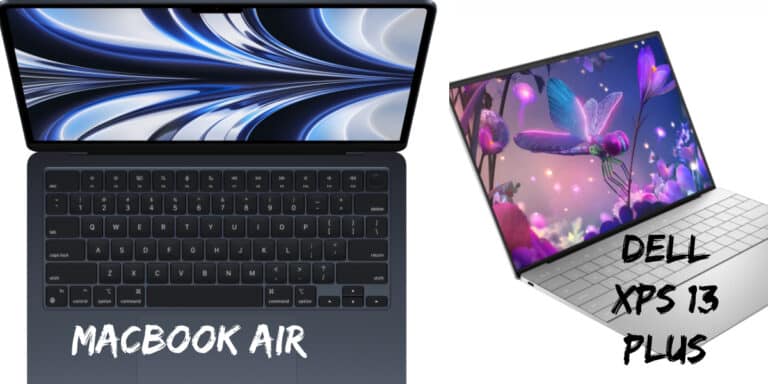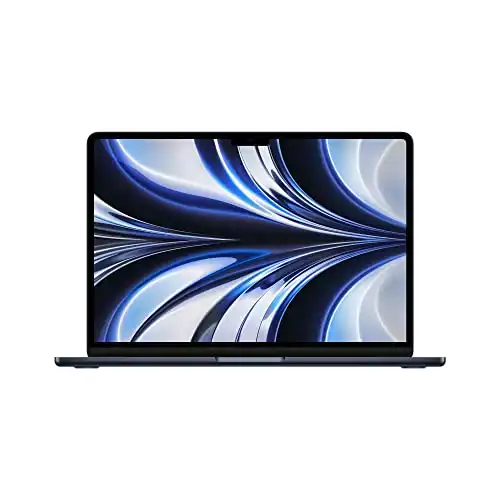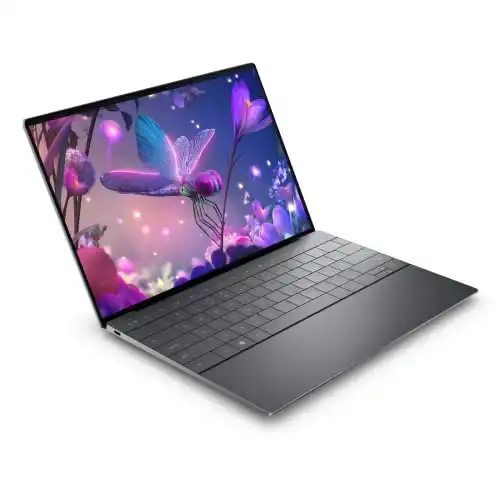Which is a better laptop for you: the Dell XPS 13 Plus or the MacBook Air M2? Both are elegant, powerful 13-inch portables with beautiful screens, strong speakers, and reasonable price list. Dell and Apple have produced two of the most inventive laptops in quite some time. The Dell XPS 13 Plus and the M2 MacBook Air each push the boundaries of laptop design in their own way. Which is more creative and worthy of your money?
Let’s examine which of these two flagship laptops is most suited to you. Both are sleek 13-inch laptops with bezel-less displays and fantastic speakers that cost the same amount of money. So deciding between the two might be challenging.
However, if you are already in the Apple ecosystem, you should consider purchasing a Macbook because it comes with the newest Ventura OS, which gives many important features for Apple devices. On the other side, the Dell XPS 13 Plus is as powerful as a Macbook but comes with Windows OS, which has less functionality than Ventura OS on Macbooks. As a result, let’s take a deep dive into this comparison to help you determine which Laptop is best for you.
What will you see here?
Overall Summary
|
4.5
|
4.5
|
|
$1,449.00
|
$2,999.00
|
|
The M2 MacBook Air is priced at $1,199. The M1-based Air will continue to be sold for $999. Education users can get one for $899. This price increase makes the M2 feel like a poorer value than the older model. The MacBook Air M2 is the slimmest laptop of this type, measuring only 0.44 inches thick. Other notebooks that come close are a few high-end Chromebooks and a few nerfed Windows laptops. It's incredibly thin without sacrificing quality, thanks to the efficiency of the M2 chip. Apple's M2 chip update is very similar in general specifications to the M1. The M2 uses an 8-core CPU split equally between performance and performance cores. It also adds a 16-core neural engine, 100GB/s memory bandwidth, and media for video encoding and decoding. The MacBook Air M2 has a higher-resolution screen and uses Apple's Touch ID fingerprint scanner for passwordless login. |
Dell XPS 13 Plus basic model starts at $1,299. The most expensive version with the best specs will set you back $2,459. UK and US upgrade parts are identical. The Australian version suffers a slight disadvantage in that you can only upgrade to an i7-1260P. The XPS 13 Plus is an entirely new direction for the XPS brand. Most of the brand's distinguishing features are gone, and it's about as daring as laptops. The keyboard extends from edge to edge, giving it a modern appearance, and the trackpad is entirely invisible. Intel Core i7-1280P and Core i5-1240P processors are at the top and mid-range of the XPS 13 Plus range. They have 6 performance cores and 8 performance cores, 20 threads, 24MB cache, and 14 cores with a maximum clock speed of 4.8GHz. Mid-range has 12 cores, 18MB of cache, 16 threads, and a clock speed of up to 4.4GHz. Dell's XPS 13 Plus laptop has a 4K display with an FHD+ InfinityEdge display with a refresh rate of 60Hz, and an anti-glare coating is available at the bottom of the price range. The impressive feature is the exceptionally narrow bezel on all four sides, including the top edge. |
|
|
|
|
The M2 MacBook Air is priced at $1,199. The M1-based Air will continue to be sold for $999. Education users can get one for $899. This price increase makes the M2 feel like a poorer value than the older model. The MacBook Air M2 is the slimmest laptop of this type, measuring only 0.44 inches thick. Other notebooks that come close are a few high-end Chromebooks and a few nerfed Windows laptops. It's incredibly thin without sacrificing quality, thanks to the efficiency of the M2 chip. Apple's M2 chip update is very similar in general specifications to the M1. The M2 uses an 8-core CPU split equally between performance and performance cores. It also adds a 16-core neural engine, 100GB/s memory bandwidth, and media for video encoding and decoding. The MacBook Air M2 has a higher-resolution screen and uses Apple's Touch ID fingerprint scanner for passwordless login.
- Thinner and lighter
- Gorgeous 13.6-inch screen
- 1080p webcam
- M2 chip delivers excellent performance
- Only supports one external screen
- Notch display design won't be to everyone's liking
- More expensive than M1 model
- Few ports
- No ProMotion
- Fast charging costs extra
- Shorter battery life than 2020 M1 MacBook Air
- Gets warm and throttles aggressively under intense workloads
Dell XPS 13 Plus basic model starts at $1,299. The most expensive version with the best specs will set you back $2,459. UK and US upgrade parts are identical. The Australian version suffers a slight disadvantage in that you can only upgrade to an i7-1260P. The XPS 13 Plus is an entirely new direction for the XPS brand. Most of the brand's distinguishing features are gone, and it's about as daring as laptops. The keyboard extends from edge to edge, giving it a modern appearance, and the trackpad is entirely invisible. Intel Core i7-1280P and Core i5-1240P processors are at the top and mid-range of the XPS 13 Plus range. They have 6 performance cores and 8 performance cores, 20 threads, 24MB cache, and 14 cores with a maximum clock speed of 4.8GHz. Mid-range has 12 cores, 18MB of cache, 16 threads, and a clock speed of up to 4.4GHz. Dell's XPS 13 Plus laptop has a 4K display with an FHD+ InfinityEdge display with a refresh rate of 60Hz, and an anti-glare coating is available at the bottom of the price range. The impressive feature is the exceptionally narrow bezel on all four sides, including the top edge.
- Gorgeous design
- Bright and vibrant OLED display
- Very comfortable keyboard
- Strong performance
- Powerful audio
- Relatively short battery life
- Touchpad can be oversensitive
- Bottom runs warm
- The capacitive function row lacks feedback
Quick Specs Comparison Table
| Specs | Apple MacBook Air M2 | Dell XPS 13 Plus |
| Price | $1,349.99 | $2,999.00 |
| Storage | 256GB to 2TB SSD | 256GB to 2TB SSD |
| RAM | 8GB to 24GB | 8GB to 32 GB |
| CPU | 8-core M2 CPU | 12th gen Intel Core i5, Core i7 |
| GPU | 8-10 core M2 GPU | Intel Iris Xe integrated graphics |
| Ports | Two Thunderbolt / USB-4 & mic | 2 Thunderbolt 4 / USB-4 |
| Weight | 2.7 pounds | 2.73 pounds |
| Size | 11.97 x 8.46 x 0.44 inches | 11.6 x 7.8 x 0.6 inches |
Price & Availability
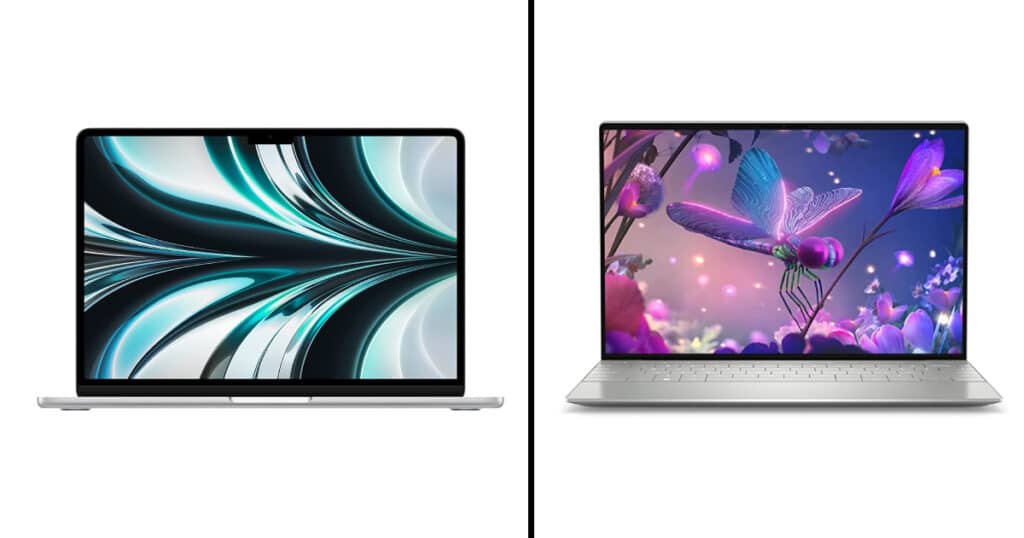
The base edition of the Dell XPS 13 Plus starts at $1,299, which is shockingly affordable for an Ultrabook. The most costly model with the greatest specifications will set you back $2,459. The majority of the upgrading parts are the same in the UK and the US. Nonetheless, the Australian version has a tiny disadvantage in that it can only be upgraded to an i7-1260P rather than the i7-1280P, which is available in the other two areas. Furthermore, both the United Kingdom and Australia lack one of the display options, and only the United Kingdom offers the Linux operating system..
The M2 MacBook Air costs $1,199. The M1-based Air will remain available for $999. Education users, on the other hand, may buy one for $899. This price rise is acceptable, but it makes the 2020 MacBook Air feel less valuable than the previous generation. This is unfortunate because one of the finest features of the 2020 MacBook Air was its affordable pricing and good performance. The base edition of the M2 MacBook Air features an 8-core CPU, an 8-core GPU, 8GB of RAM, and 256GB of SSD storage.
MacBook Air M2 vs. Dell XPS 13 Plus – Design
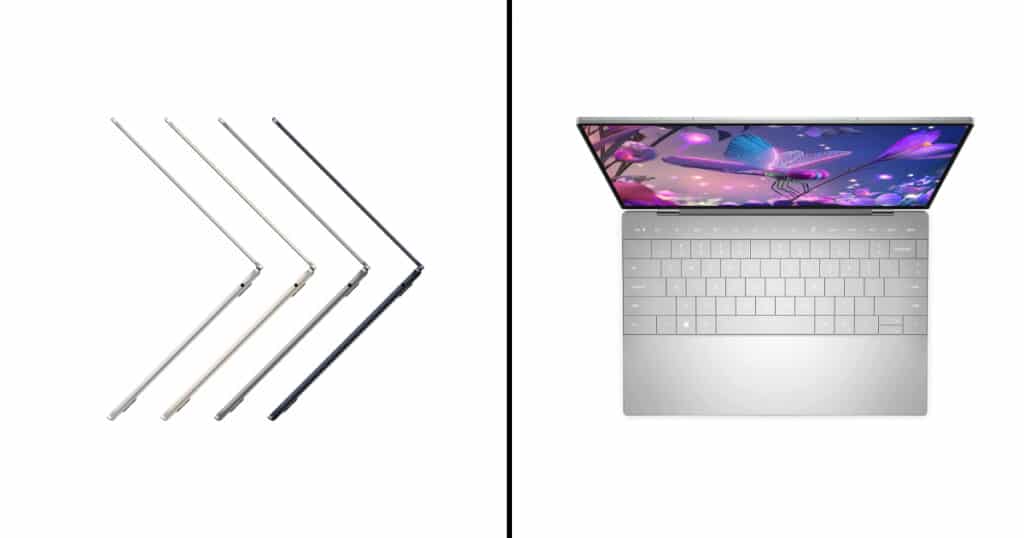
In terms of aesthetics and design, both of these PCs are cutting-edge. Dell also refers to its XPS series as lightweight, which is similar to how Apple refers to its Macbook Air line. The MacBook Air M2 seems more conventional since it condenses numerous design features from the MacBook Pro 14 and 16-inch into a smaller size. The notch reveals that the slimmer bezels, rounded edges, and flat lids are all clones of the Macbook Pro series. Both laptops are made of metal and have the same build quality.
The XPS 13 Plus represents a complete new XPS brand approach. The majority of the brand’s distinguishing features have been erased, and it is about as daring as computers. Because it spreads from edge to edge, the keyboard has a modern appearance. Meanwhile, the trackpad is entirely obscured. It, like the MacBook Air, features a haptic feedback trackpad, implying that there is no actual click mechanism. The Dell XPS 13 Plus looks and feels comparable to the MacBook Air.
Nonetheless, in relation to its size, the MacBook Air M2 is exceptionally thin. It is the thinnest laptop of its class, with a 0.44-inch thickness. However, it is not as small as the Dell XPS 13 Plus. The Dell XPS 13 Plus is slightly smaller, measuring 11.63 inches by 7.84 inches, as opposed to the MacBook Air M2, which measures 11.97 inches by 8.46 inches. Because to the efficacy of the M2 processor, the MacBook Air is relatively tiny without sacrificing quality. Simply put, it alters the game. In comparison, the XPS 13 Plus is compact in its own special way.
Performance & Specs
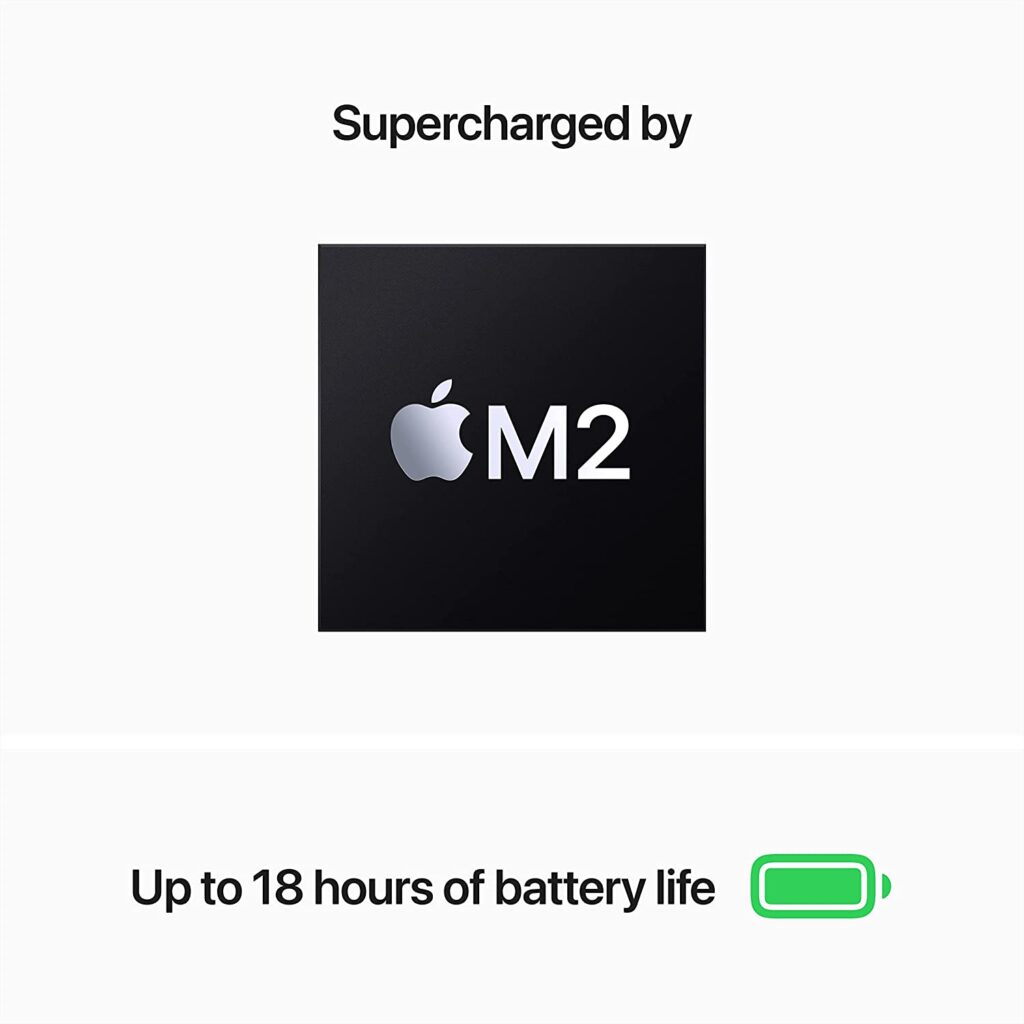
If it in terms of performance, the Apple MacBook M2 comes out on top. It incorporates the brand-new Apple M2, which is a flagship CPU. The MacBook M2, because it is so thin and compact while providing top-tier speed, has a really stunning look. In all GPU performance tests, including intense video editing jobs, the MacBook Air M2 surpasses the Dell XPS 13 Plus. In terms of general specifications, the M2 CPU isn’t significantly better than the previous generation M1 microprocessor. However, the M1 CPU outperformed the bulk of expensive laptops on the market in terms of performance.
Three 12th generation CPUs are available for Dell systems. The Core i5-1240P is a fantastic choice if you need a high-end laptop on a small budget but will not be using it for hard work because it performs well on ordinary everyday tasks and has a long battery life. But suppose you want a laptop that can handle demanding tasks like editing or business travel. In this scenario, you may consider the mid-range Dell XPS 13 Plus, which comes with the Core i7-1260P, which is appropriate for intense work due to its 12 cores and 4.4GHz clock speed.
If money is not a concern and you want a high-end, premium laptop, the top-tier Dell XPS 13 Plus model, which arrives with a Core i7 processor that can easily handle most demanding jobs and gives the best performance, is a good option.
In conclusion, both provide the finest performance in terms of professional and daily work. However, the Dell XPS 13 Plus with high-end specifications does well in multitasking tests since it has more CPU cores and dual channel LPDDR5 RAM.
MacBook Air M2 vs. Dell XPS 13 Plus – Display
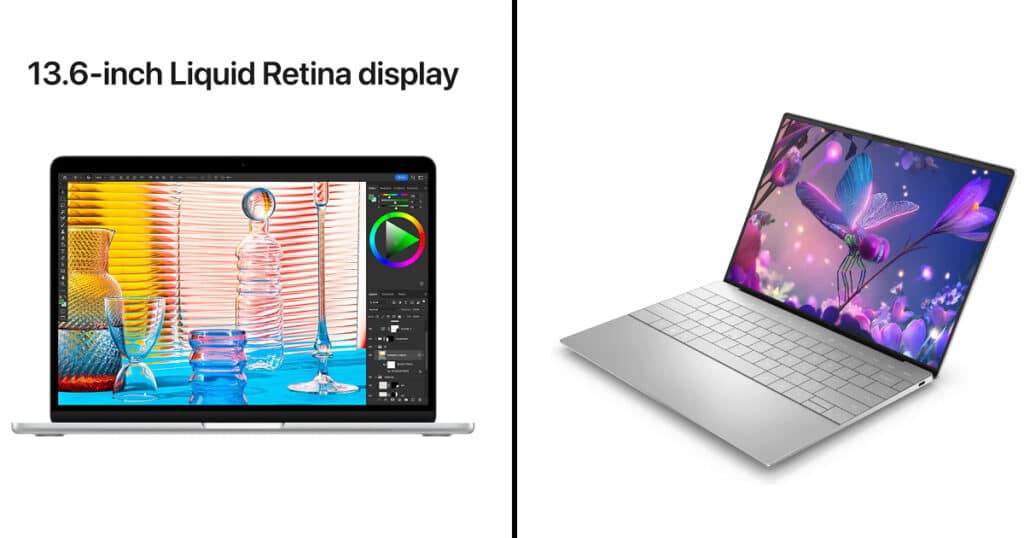
The display is the feature of any luxury laptop that demands special attention. For the MacBook Air M2, Apple only offers one display option. The only display provided is a 13-inch Liquid Retina display with a crisp, high resolution of 2560 x 1664. However, it lacks the HDR capabilities seen on more expensive MacBook Pro versions. You won’t have any problem using this laptop outside thanks to its 500nit display brightness.
The Dell XPS 13 Plus, on the other hand, features a plethora of display options. If you want a flagship-like experience, the OLED display is the best and most expensive option, and it is strongly recommended. If money is a concern, consider getting the lower-resolution LED model, which nonetheless gives a nice viewing experience. Furthermore, the OLED version of the panel offers a similar brightness of up to 500 nits. In compared to the Dell XPS 13 Plus, the display on the MacBook looks to be more vivid and colourful in person. The lack of a touchscreen on the MacBook display is its one flaw; by contrast, Dell’s touchscreen panel is smooth and very responsive.
Webcam
In addition, the MacBook Air M2 has a higher-resolution camera than the XPS 13. It also has an Apple Touch ID fingerprint scanner for password less login, whilst the XPS 13 includes a fingerprint reader as well as an infrared camera for facial recognition.
MacBook Air M2 vs. Dell XPS 13 Plus – Battery life

Dell’s XPS laptops struggle to last more than 7 hours, and the XPS 13 Plus is no exception. If you pay for the sharp-looking OLED display. The Dell XPS 13 Plus, on the other hand, lasts 7 hours and 34 minutes. However, Dell claims that without the OLED display, the XPS 13 Plus may last up to 13 hours on a single charge. That is insufficient to get through a full day of work without needing to plug in to charge. In comparison to the Dell XPS 13 Plus, the MacBook Air M2 has much greater battery life.
Apple has made several battery life improvements as a result of the new M2 processor, allowing the new M2 chip to make the most of the battery life. Because the M1 chip was the greatest in terms of battery life and the M2 chip is an updated version of it, it delivers the best battery backup of 18 hours. In real-world battery usage, the MacBook Air M2 boasts a 14-hour and 6-minute battery life. That’s nearly twice as long as the XPS 13 Plus OLED’s battery life. So, if battery life is your primary issue, Apple’s laptop comes out on top.
Key Differences
Both laptops are much different from each other, so there are several features that differ from each other.
- To begin with, the MacBook Air M2 features its own newest and most powerful CPU, the M2 chip. It is intended by Apple to perform smoothly with the programmes that come pre-installed in the MacBook and has a longer battery life than any other laptop. Dell XPS 13 Plus, on the other hand, provides the Inter iCore 12th gen series, with a choice of i5 or i7 processors. Indeed, 12th generation CPUs are highly strong and power efficient, providing comparable performance to the Apple M2 chip but lacking in battery backup.
- Another noteworthy difference between the two computers is their screens. Apple provides a Liquid Retina display that supports Wide Color (P3) and True Tone. It also has a refresh rate of 60Hz, a peak brightness of up to 500 nits, and a resolution of 2,560 x 1664, which is sufficient for any professional user. The Dell XPS 13 Plus, on the other hand, provides a variety of display alternatives.
- Resolution- The Dell XPS offers a flagship-level OLED display with 1,920 x 1,200, 3,456 x 2,160, or 3,840 x 2,400 resolutions. To compete with Apple’s MacBook Air M2, choose for the OLED model, which has a higher contrast ratio and crisper, more vibrant colours than MacBooks with a resolution of 2,560 x 1,664.
- There is also a difference in contrast ratio between the two displays; the MacBook has a contrast ratio of 1500:1, which is significantly lower than the top-end OLED display of the Dell XPS 13 Plus, which has a contrast ratio of 100000:1.
- In terms of structure and style, the Apple MacBook is somewhat larger and thinner than the Dell XPS 13 Plus. Also missing from the MacBook Air is an audio jack, which is a disappointment for Apple lovers.
- Both laptops include a webcam. However, the MacBook Air M2 has a higher-resolution camera in the notch, whilst the Dell XPS 13 Plus has a webcam in the bezel.
- In terms of battery life, the Apple MacBook Air M2 has its own M2 processor, which
Key Similarities
In terms of significant commonalities, both laptops are designed for distinct people’s situations. As a result, the only similarity is the design, which is extremely similar when the lid is closed. In addition, the base variants of both laptops have the same amount of RAM and the same two USB-C Thunderbolt 4 connections, which facilitate high-speed transfers with ease.
Conclusion
When deciding between these two devices, most customers will choose with the operating system with which they are most familiar. In any case, you’re getting a fantastic, high-end laptop. Users love the XPS 13 Plus’s striking design, but if you really need to compare both, the MacBook Air M2 is the superior computer. It’s faster, lasts far longer on a single charge, and even offers a significantly better video conferencing and media experience. Surprisingly, the two laptops are priced similarly depending on configuration.
Read More:
- MacBook Air M2: A Thinnest Deserving Laptop with improved performance!
- Dell XPS 17: The big XPS laptop is back!
- XPS 13 plus vs. XPS 13 Dell: Which is superior?
- iPad Pro with M2 Chip: A dynamite launch of the year!
- Dell XPS 15 OLED – Does it holds the reputation of its predecessor?


